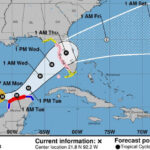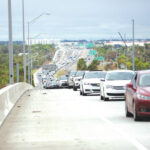Dire warnings for storm-weary Floridians as Hurricane Milton approaches


MIAMI — Weary Floridians on Monday steeled themselves for a second major hurricane in two weeks, wrestling with anxiety about whether to leave their homes and where the storm might go as Hurricane Milton took aim at much of the state’s battered Gulf Coast.
The vulnerable Tampa Bay region, a metropolitan area that is home to more than 3 million people, faced mass evacuations of low-lying communities that were flooded only days ago by the devastating storm surge of Hurricane Helene. Evacuation orders extended south along the coast, where Hurricane Ian made landfall in 2022, killing about 150 people.
Milton, which formed as a tropical storm Saturday afternoon, rapidly intensified from a Category 1 to a Category 5 hurricane over a few hours Monday morning. Forecasters expect it to weaken somewhat before making landfall somewhere between Naples and Cedar Key, with possible storm surge of up to 12 feet.
Although Floridians were suffering from hurricane fatigue, the fresh memories of Helene, Ian and Hurricane Idalia, which struck the Gulf Coast last year, spurred some people to evacuate for Milton even if they had not done so before.
“Our house was just flooded, and we just started to put it back together again,” Jeff Monsein, 65, said as he boarded up his home in Davis Islands near downtown Tampa on Monday morning. His family did not think it would get hit by a hurricane, much less two.
Monsein did not evacuate for Helene but said he would for Milton. His 85-year-old mother has Stage 4 cancer and her condominium flooded during Helene, so she moved in with him, he said. In all, two homes and four cars were damaged.
Ahead of Milton, Monsein tried to wait in line for sandbags, but it took so long that he gave up.
“It’s an hourly, daily kind of life right now,” he said.
Milton will test storm-recovery operations for Florida and the federal government with resources strained across the Southeast because of Helene, which cut a deadly path from Florida through North Carolina.
On Monday, President Joe Biden signed an emergency declaration for Florida to facilitate emergency assistance. Milton threatens to further shake the state’s insurance market, which has struggled as private insurers strain to pay growing hurricane claims.
Florida Gov. Ron DeSantis said the state had marshaled fuel supplies, power utility crews and ambulances. Tolls were suspended along evacuation routes, and certain state buildings and vacant buildings could be put to use as added emergency shelters if places already designated as such filled up with evacuees.
“If we knew exactly where it’s going to hit, we probably would evacuate fewer people,” DeSantis said in a Monday news briefing. “But we don’t know that.”
Where Milton comes ashore will serve as something of a dividing line, with the worst of the storm surge forecast to its south.
In Fort Myers Beach, near where Hurricane Ian came ashore two years ago, Teri Cado and her husband rushed to prepare their recreational vehicle Monday and move off the barrier island. They have not yet rebuilt the home that Ian destroyed.
“We’re OK. We’re resilient. And we are doing everything we can,” Cado said, pausing briefly. “When you are hanging by a thread, reach a little higher and there’s a rope.”
Helene made landfall hundreds of miles north, but it still flooded houses in Fort Myers Beach and spewed sand and debris along the roads.
Karen Woodson, a Town Council member, and her husband lost appliances, flooring, furniture and 18 inches of drywall in their newly redone waterfront home along Third Street.
“This is a tough one,” Woodson said Monday, as the couple finalized preparations to move to a hotel on the mainland. “You just have to compartmentalize and do what’s best for you in the moment.”
“I’m good,” she added, “until somebody hugs me.”
Piles of sand and debris dot the streets of Fort Myers Beach and other barrier islands and low-lying communities up the Gulf Coast, which has prompted officials to start an urgent, 24-hour removal operation ahead of Milton. Piles of debris could take flight in the new storm if left along the streets.
Rick Borman, who manages a condo complex in Fort Myers Beach that is still under reconstruction from Ian, said he had been fielding calls from worried out-of-town owners. Full-time residents, he said, have struggled with symptoms of trauma, especially after Helene.
“It’s like there’s a boogeyman at the door,” he said.
Mental health workers in Fort Myers set up contingency plans for patients to continue receiving services during the storm. Dr. Anthony Garcia, a psychologist and the owner of A Peaceful Mind Counseling Group, said his team of therapists was equipped with phones that receive priority service on satellite signals.
The prospect of Hurricane Milton “obviously stirs the pot for a community that’s still — we’re literally still building from it, and an understandable trigger for everyone, myself included,” he said.
Garcia said treating a patient anticipating a major hurricane was far different from therapy for grief about a past event.
“It’s the unknown,” he said. “It’s this lingering monster out there that we don’t know, and we don’t know what it’s going to do.”
In Tampa, local officials acknowledged that bracing for another storm would be expensive, difficult and stressful.
“We are still reeling from Helene,” Mayor Jane Castor said. “And now we have Milton on the way. That isn’t just going to be a water event, it’s going to be a surge event, it’s going to be a rain event, it’s going to be a wind event.”
More than a century has passed since the Tampa Bay region sustained a direct hit from a major hurricane.
Forecasters and residents hold their breath every time a storm is on a possible track to hit directly, knowing that the storm surge could be catastrophic.
The last storm to land directly was in October 1921, when the population was only about 120,000 people.
“We are telling people this will be like the worst hurricane in their lifetime in Tampa Bay,” said Rick Davis, a meteorologist at the National Weather Service in Tampa.
Erika Nowlin, 27, of Pinellas Park, near St. Petersburg, said she had never experienced natural disasters growing up in Virginia. She moved to the Tampa area four years ago and said she would ride out the looming hurricane inland, in Orlando with her pets. Seeing what Helene wrought made her nervous.
“I don’t expect to stay in Florida” long term, she said. “I don’t think I can go through that many hurricane seasons.”
This article originally appeared in The New York Times.
© 2024 The New York Times Company



